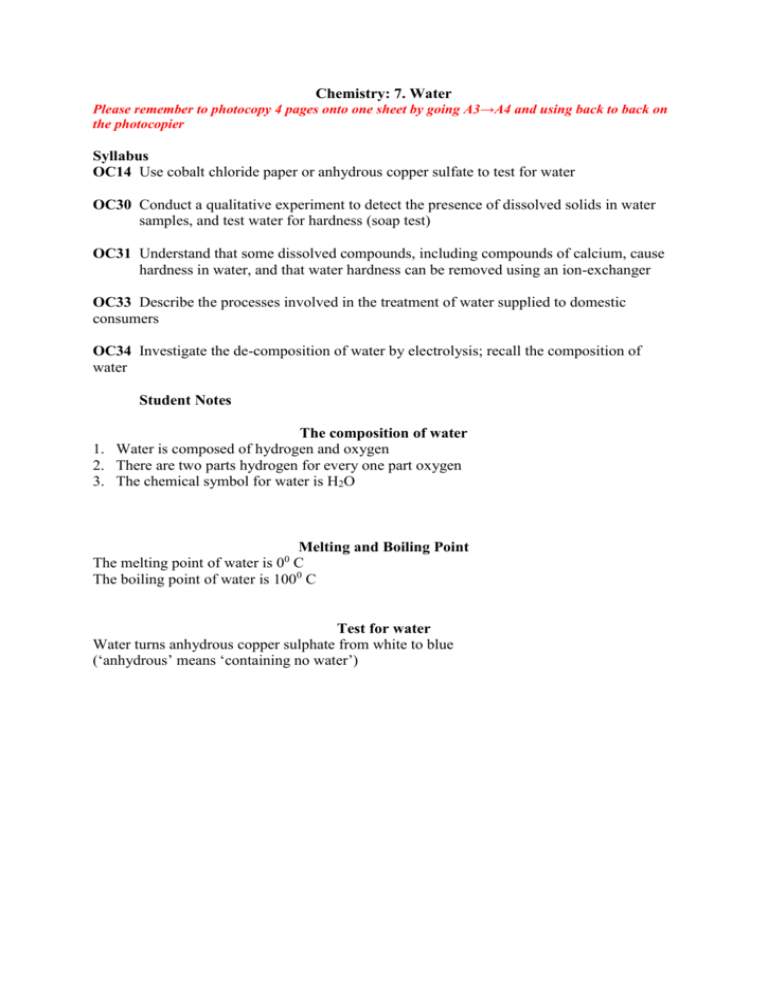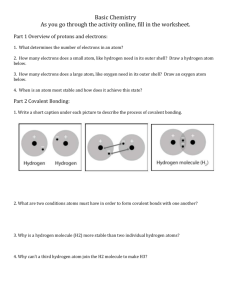Chemistry 3
advertisement

Chemistry: 7. Water Please remember to photocopy 4 pages onto one sheet by going A3→A4 and using back to back on the photocopier Syllabus OC14 Use cobalt chloride paper or anhydrous copper sulfate to test for water OC30 Conduct a qualitative experiment to detect the presence of dissolved solids in water samples, and test water for hardness (soap test) OC31 Understand that some dissolved compounds, including compounds of calcium, cause hardness in water, and that water hardness can be removed using an ion-exchanger OC33 Describe the processes involved in the treatment of water supplied to domestic consumers OC34 Investigate the de-composition of water by electrolysis; recall the composition of water Student Notes The composition of water 1. Water is composed of hydrogen and oxygen 2. There are two parts hydrogen for every one part oxygen 3. The chemical symbol for water is H2O Melting and Boiling Point The melting point of water is 0 C The boiling point of water is 1000 C 0 Test for water Water turns anhydrous copper sulphate from white to blue (‘anhydrous’ means ‘containing no water’) Water hardness Hard water does not easily form lather with soap Hardness in water is caused by dissolved compounds, particularly compounds of calcium and magnesium To investigate the hardness in different water samples Note: Hard water causes a scum to form and requires a large volume of soap to form a lather. Procedure 1. Pour water from the various samples into different test tubes. 2. Make sure to use the same amount of water in each test tube (can you explain why?). 3. Add the same number of soap flakes to each test tube (can you explain why?). 4. Shake the mixtures. Result Lather forms in the test tubes containing soft water. No lather will form in the test tubes containing hard water. Soft water easily forms lather with soap Advantages of hard water Good source of calcium for strong bones and teeth Most prefer the taste of hard water Disadvantages of hard water Limescale blocks pipes and reduces efficiency of kettles, washing machines. Wastes soap and leaves a scum which can be difficult to remove from clothing. Removal of hardness Water hardness can be removed using an ion-exchanger Slowly pour the hard water The ion exchanger works by replacing the ions in the hard water which cause hardness with ions that don’t cause hardness e.g. sodium ions To detect the presence of dissolved solids in water samples 1. Pour a water sample into a beaker and boil allow the water to boil off. 2. The dissolved solids will remain on the sides of the glass and on the bottom of the beaker. Water treatment Water is treated at a waterworks to make it fit to drink. There are five stages: 1. Screening – removes large debris by passing water through a wire mesh 2. Settling – aluminium sulphate is added to the water. It makes the particles stick together and settle on the bottom. 3. Filtration –very small dirt particles are removed through filtration. 4. Chlorination – Chlorine added to kill germs (‘sterilising’/ ‘disinfecting’) 5. Fluoridation – In Ireland fluorine is added to the water to prevent tooth decay. (Make up your own acronym for the five stages) Electrolysis of water Electrolysis is the splitting up of a compound by passing electricity through it Electrolysis of water splits water into hydrogen and oxygen To investigate the de-composition of water by electrolysis 1. Set up as shown (the apparatus is known as a Hoffman Voltameter) Pure water is a poor conductor of electricity so a little dilute sulphuric acid can be added. 2. Notice that the gases formed are in the ratio 2:1 3. Test for Hydrogen (it burns with a ‘pop’). 4. Test for oxygen (it relights a glowing splint). Chemistry: 11. Plastics Please remember to photocopy 4 pages onto one sheet by going A3→A4 and using back to back on the photocopier Syllabus OC58 Identify everyday applications of plastics, and understand that crude oil products are the raw material for their production OC59 Relate the properties of plastics to their use OC60 Describe and discuss the impact of non-biodegradable plastics on the environment OC61 Understand that chemistry has an important role in pharmacy, medicine and the food industry. Student Notes Plastics are made from crude oil Crude oil is unrefined oil – it needs to be purified before it can be used. Remember that oil is a fossil fuel and that fossil fuels are formed from the remains of plants and animals that lived thousands or millions of years ago Everyday applications of plastics 1. Electrical insulation 2. Food containers 3. Packaging 4. Pipes Relating the properties of plastics to their use Property Rigid Electrical insulators Flexible Heat insulators Waterproof Use Furniture Wire insulation Hose pipes Polystyrene cups Buckets Non-biodegradable plastics Non-biodegradable plastics do not break down in nature Impact on the environment 1. Small pieces of plastic can get eaten by animals and birds on land and by fish in the sea which causes choking. 2. In the sea many fish can get trapped in plastic bags. 3. Plastic gives out an enormous amount of poisonous smoke when burnt which can be fatal in a house fire. Chemistry: 13. Ionic and Covalent Bonding Please remember to photocopy 4 pages onto one sheet by going A3→A4 and using back to back on the photocopier Syllabus OC41 Understand how atoms of elements combine to form compounds OC42 Recall that ionic bonding is an attraction between positive and negative ions; describe the bonding in NaCl and MgO as examples OC43 State what a molecule is, understand that covalent bonds involve the sharing of pairs of electrons, and describe the bonding in H2, O2, H2O, CH4 as examples of covalent bonding OC44 Investigate the ability of ionic and covalent substances to conduct electricity Student Notes Compounds and Molecules Remember our definitions of molecules and compounds from chapter 2: Elements, Compounds and Mixtures? A molecule is made up of two or more atoms chemically combined. A molecule is the smallest part of an element or compound that can exist on its own Compounds are substances made from two or more different elements chemically combined. So what does this phrase ‘chemically combined’ mean? First we need to note that there are two ways for atoms to combine chemically, and that another word for the process of combining chemically is ‘bonding’. Bonding Bonding occurs because all atoms try to have a full outer shell, and will lose, gain or share electrons in order to do There are two separate methods by which atoms join up: 1. Ionic bonding occurs when an atom loses or gains electrons 2. Covalent bonding occurs when an atom shares electrons. Ionic bonding An ion is a charged atom – i.e. an atom which has lost or gained electrons If an atom loses an electron then it becomes a positive ion. If an atom gains an electron then it becomes a negative ion. In ionic bonding positive ions are attracted to negative ions. An ionic bond is a bond formed by the force of attraction between two oppositely charged ions An example of an ionic bond is sodium chloride The bonds in sodium chloride are formed by sodium atoms losing electrons and chlorine atoms gaining electrons. Examples of ionic bonding: (i) Sodium Chloride (NaCl) The atomic number of sodium is 11. It has an electronic configuration of 2, 8, 1. This means that it needs to lose the one electron which it has in its outer shell in order to have a complete outer shell. The atomic number of chlorine is 17. Chlorine has an electronic configuration of 2, 8, 7. This means it needs to gain one electron in order to have a complete outer shell. When a sodium atom bonds with a chlorine atom the sodium atom loses its outer electron to form a positive ion while the chlorine atom gains an electron to form a negative ion. The two atoms now have opposite charges and because opposite charges attract both atoms move off together as a sodium-chloride (NaCl) molecule. Examples of ionic bonding: (ii) Magnesium Oxide (MgO) The atomic number of magnesium is 12. It has an electronic configuration of 2, 8, 2. This means that it needs to lose the two electrons which it has in its outer shell in order to have a complete outer shell. The atomic number of oxygen is 8. Oxygen has an electronic configuration of 2, 6. This means it needs to gain two electrons in order to have a complete outer shell. When a magnesium atom bonds with an oxygen atom the sodium atom loses its two outer electrons to form a positive ion while the oxygen atom gains two electrons to form a negative ion. The two atoms now have opposite charges and because opposite charges attract both atoms move off together as a magnesium-oxide (MgO) molecule. When I heard that oxygen and magnesium hooked up I was like OMg. Covalent bonding A covalent bond is a bond formed by different atoms sharing electrons in order to have a complete outer shell Examples of covalent bonds are H2, O2, H2O and CH4 (methane) molecules. The bonds in these molecules are formed by the atoms in the molecules sharing electrons with each other.. Examples of covalent bonding: (i) A hydrogen molecule (H2) The atomic number of hydrogen is 1. It needs to have two electrons in its outer shell, and so if it ‘bonds’ with another hydrogen atom and they both ‘share’ their electron with each other, it has the effect of allowing both atoms to have a complete outer shell. Examples of covalent bonding: (ii) An oxygen molecule (O2) The atomic number of oxygen is 8. It has an electronic configuration of 2, 6. It needs to have 8 electrons in its outer shell, and so if it ‘bonds’ with another oxygen atom and they both ‘share’ two of their electrons with each other, it has the effect of allowing both atoms to have a complete outer shell. Examples of covalent bonding: (iii) A water molecule (H2O) The atomic number of hydrogen is 1 so it has 1 electron in its outer shell. The atomic number of oxygen is 8 so it has 6 electrons in its outer shell. Oxygen can share 1 electron with one hydrogen atom and a second electron with a second hydrogen atom, which has the effect of allowing all atoms to have a complete outer shell. Examples of covalent bonding: (iv) A methane molecule (CH4) The atomic number of hydrogen is 1 so it has 1 electron in its outer shell. The atomic number of carbon is 6 so it has 4 electrons in its outer shell. Carbon can share 1 electron with each of 4 different hydrogen atoms, which has the effect of allowing all atoms to have a complete outer shell. To investigate the ability of ionic and covalent substances to conduct electricity Procedure Set up a circuit as shown in the diagram. Select a number of different substances for testing, e.g. table salt, copper sulphate (both ionic substances), cooking oil and sugar (both covalent substances). If the substances are solid then they should be dissolved in pure water before testing. If the bulb glows then the substance is a conductor and if it doesn’t glow then it is an insulator. Result The bulb will only glow for ionic substances. Conclusion Only ionic substances conduct electricity. Silly exam question: Why were the solid substances dissolved in water before the investigation? Answer: To allow the particles to move Properties of Ionic and Covalent compounds Ionic Compounds Usually solid at room temperature High melting and boiling points Soluble in water Conducts electricity Undergo fast reactions Covalent Compounds Usually liquid or gas at room temperature Low melting points Insoluble in water Do not conduct electricity Undergo slow reactions





